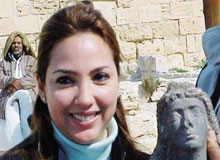Some people turn boredom into naps. Kathleen Martinez Berry creates entire careers out of idle moments.
Up at night with an infant and temporarily living in Madrid while her husband studied cardiology, Martinez cast about for something challenging to occupy her time; she decided to get a master’s degree in finance.
Bored again while tending to her second child, Martinez then earned a master’s in archeology, a subject that had been a longtime passion. That rekindled what has become a full-blown obsession: discovering the truth about the life and especially the death of Cleopatra, the last queen of Egypt, at one time the richest and most powerful woman in the world.
Her quest has transported Martinez from a high-powered career as one of the Dominican Republic’s most sought-after criminal attorneys, into a self-made Egyptologist poised at the brink of solving one of archeology’s most enduring mysteries — the whereabouts of Cleopatra’s tomb.
Martinez recalled her adventures while in Abu Dhabi, where she was a panelist for the Higher Colleges of Technology’s Festival of Thinkers event. Her message to Emirati students was to follow one’s dreams and to never take no for an answer. Her life is a case study of that motto and belief.
Martinez’s path began in Santo Domingo, the Dominican Republic, where her French-English mother and her attorney father doted on their only child, creating a rigorous intellectual life. Little Kathleen was often allowed to sit in on her father’s Sunday salons, where the country’s prominent intellectuals gathered to debate big ideas in the family’s library, the largest private book collection in the Caribbean.
Martinez’s academic training didn’t preclude other pursuits: At various times, she’s been a chess champion, an accomplished swimmer, and is proficient at judo, karate and the piano.
Her hunger to learn showed itself at an early age. As a five-year-old on her first day of preschool, Martinez was handed drawing paper and crayons. She raised her tiny hand, explaining to the teacher that she could draw at home. “Is there anything you can teach me?” she asked.
The next day, the girl was told to report to the first grade. After a week of similar raised-hand requests for teaching, Martinez was nearly promoted out of elementary school. She graduated from law school at 18. The Dominican system requires law students to try actual cases before leaving school. Martinez took on a politically-charged case involving a banker who was set up, a cause that none of the country’s practicing attorneys wanted to take on. She won. After graduation she was hired by the city’s most prominent criminal attorney, who told her, “Now, I will teach you the law.”
Another Adventure
Martinez worked for 20 years building a client base, eventually establishing her own firm. For many people, that would have been enough. Even after the five-year hiatus in Madrid, Martinez expected to return to the Dominican Republic and reopen her office. “My clients came back. It was just like before,” she says. “I never imagined that I would start another adventure.”
But hers was a restless mind. She never shook off an exchange with her father from years before. Martinez had been browsing through his library in 1990, looking for something to read. She picked up Shakespeare’s Antony and Cleopatra, which her father dismissed. Cleopatra was a mere political schemer, he said, not even deserving of a historical footnote.
“Why do you speak of the queen like this?” she recalls. “How do you know? What are your sources?”
Martinez vowed to find out for herself, a daunting task in a small Caribbean island in a pre-Internet world. “I read everything, Plato, Socrates, especially the Romans,” she says, adding that she came to understand the axiom that history is written by the winners. “Of course, the Romans hated the Egyptians. They attacked her beauty — she was plain, but it does not matter. Then I looked for Egyptian sources, and they described a different person. They said she was the greatest of her dynasty. She ruled the most important country in the world. She was the most important woman on earth. She was a queen when she was 18 years old. I concluded that Cleopatra was a special woman. She spoke nine languages, wrote about the law and medicine. Every day I got more and more interested in this woman.”
But, being who she was, Martinez could not stop there. She devoured the Cleopatra story, trying to read past historical bias and understand the young queen as a woman and a mother. With this perspective, Cleopatra’s political maneuverings and personal choices came into sharper relief. Even the oft-told story of how Cleopatra first presented herself to Julius Caesar, rolled up in a rug, is viewed by Martinez as nothing less than a stroke of military and strategic genius.
“Cleopatra was on the run, hiding in the desert and learned Caesar was in Alexandria,” she said. “She needed to meet him, but how? She came up with a plan, arranging for a rug to be presented as a gift from her. Now, this was a Roman general. The most protected man. If she were caught, she would be dead in an instant. It was incredible. Imagine [sneaking] into Barack Obama’s office. I became an admirer of hers.”
Martinez continued her law practice but devoted her spare time to Cleopatra research. In particular, she began to formulate a theory about why Cleopatra’s tomb — believed to contain a treasure trove — had never been found. Martinez thought historians had failed to consider a critical point: Cleopatra believed she was the living form of the goddess Isis, and that Marc Antony, with whom she had a 12-year relationship and three children, was the god Osiris. She considered how Cleopatra and Marc Antony died and how their deaths mirrored the deaths of Isis and Osiris, two of the most powerful figures in Egyptian mythology.
“I studied how she died,” Martinez said. “In that time, death was a critical moment and very meaningful. She used a cobra to kill herself. A snake was smuggled to her in a basket, hidden underneath figs. I have visited many jails in the Dominican Republic. It would have been difficult to smuggle something in, especially a snake. Why not have a small vial of poison brought in? There are three goddesses in the form of a snake, and Egyptians used a cobra to protect the pharaohs. Her death was a message to her followers. She wanted to die as a goddess.
“It came to me: Cleopatra’s tomb has never been found because she wasn’t buried in a tomb. She and Marc Antony were buried in a temple to Isis and Osiris. There has to be a temple. But which one?”
Hollywood Tale
It was 2002, and all spare surfaces in Martinez’s home were covered with maps. She was plotting the sites of all the known temples to Isis and Osiris. For the first time, after her years of obsession, Martinez planned a trip to Egypt. She spent months calling and faxing the Egyptian government, asking permission to go to the temples that were not open to the public. They never responded.
“I went anyway,” Martinez says, the determination still evident in her voice. “My family cried, they said the Egyptians would kill me. But when I think to do something, I go all the way until I get it.”
What followed is a tale straight out of an espionage film, but Hollywood would no doubt reject the plot as implausible. Traveling with a cousin, Martinez arrived in Cairo early in the morning. The immigration officer scanned her passport and derisively called it a ‘Mickey Mouse’ document. She was detained and taken to a room for questioning, more than a bit frightened, and thinking about how the Dominican Republic didn’t have an embassy in Cairo.
Martinez was held in the room for hours. Finally an official ordered her and her cousin to get into a van, which he said would take them to their hotel. Martinez was suspicious and asked to go to the restroom, stalling for time and waiting until airport shops opened. On her way back Martinez ducked into the first open store, a travel agency. She plopped into the chair and hurriedly requested a car, driver and a Spanish-speaking guide.
“The man behind the counter said, ‘But you speak English.’ I insisted on a Spanish interpreter because I knew it would take more time to find one. I wanted to pay for it right away, using a credit card so my family could track me in case anything happened.”
In retrospect, Martinez said she was probably overreacting, and there was no reason to believe that the van would have done anything other than take the pair to their hotel. She didn’t know it at that moment, but the episode served a purpose. She did get the guide and it turned out that he knew the scheduling secretary for the Egyptian Minister of Antiquities. The next day, she had a 10 a.m. appointment.
Martinez was nervous and had two minutes to make a case for permission to explore temples open only to archeological research. To her surprise, she was given approval for two months to examine temples. They crisscrossed the country, using the temple maps of Isis and Osiris Martinez had prepared in Santo Domingo. Nothing seemed right. Finally, with time running out, they visited the last site, Taposiris Magna Temple, about 50 kilometers west of Alexandria. Martinez had a hunch about this site, which had been excavated for hundreds of years. The temple was all-but destroyed, but Martinez got chills.
“The instant I entered I knew,” she says. “It was only ruins, but in my mind I had the imagination. I knew. I thought, how come no one sees this?”
The realization that this might be the long-sought tomb of Cleopatra and Marc Antony was overwhelming. The possibility hit her that her long obsession, quietly pursued against all odds on an island across the world, might actually bear fruit. At that moment Martinez at last considered what might come next, the near-impossibility that the Egyptian government would grant her one of the precious excavation permits — a nobody with a crazy theory that generations of archeologists had somehow overlooked.
“I sat against the remains of a column and I cried,” Martinez says. “Why? I am a citizen of the Dominican Republic. I am not a famous archeologist. I don’t have a big school like Harvard behind me. I thought, ‘I have come this far but no one will listen, no one will give me permission.’ Then I stopped crying and thought, ‘I have to fight until they tell me yes, if it takes the rest of my life.'”
Excavating a Theory
Martinez returned home and set about organizing her return to Cairo. She made a presentation to a university in Santo Domingo and gained its support. She met with the Minister of Foreign Affairs to deal with her ‘Mickey Mouse’ passport. Soon Martinez had been appointed the nation’s first Minister of Culture to Egypt and was issued a diplomatic passport.
Six months after she left, Martinez was back in Egypt and once again sitting across from Egyptian Supreme Council on Antiquities.
“Again, I have two minutes,” she said. “I say, ‘I think I found the tomb of Cleopatra.’ He leans forward. ‘What did you say your name is?’ He had not been paying attention. I said, ‘You gave me two minutes, please allow me to finish. Cleopatra was the last queen of Egypt, if you don’t care about her, you should quit your job.'”
Impressed by either her scholarship or her tenacity or both, the official gave Martinez permission to go before a committee that grants excavation permits. The odds were long; each year there are 2,000 applications for 150 places. Undeterred, Martinez made her case and went home.
Three weeks later, she was notified that her projects was approved. But instead of the usual year-long permit, Martinez was granted only two months to find artifacts that proved her theory. She explained to her family that her project was approved. They told her, ‘You are a dreamer. You are obsessed and have gone crazy.’ Her father discouraged her. Martinez sought the counsel of her uncle, who told her, ‘If you are not right, your career will be over. You cannot go back.’
“I knew he was telling the truth,” she says, but was willing to wager her career in pursuit of her dream.
There was another obstacle: Martinez had no team and no funding to undertake a major dig, certainly not under the time pressure. Using her own money at first and teaming with the Egyptian government and Zahi Hawass, the former Minister of State for Antiquities Affairs, Martinez returned to the site and began excavations in 2004.
From the start, the excavations unearthed intriguing finds. Workers found six burial chambers, not before found in a temple, changing what was known about the architecture of temples and tombs. The site also contained 40 coins with the image of Cleopatra and Marc Antony, an alabaster head of Cleopatra, metal plates and other items that lent credence to Martinez’s theory.
Hawass was confident enough to tell reporters, “The discovery of the tombs inside this temple shows that someone important was buried here. We are excavating a theory. If we discover the tomb of Marc Antony and Cleopatra, it would be the most important discovery of the 21st century. If we don’t discover the tomb of Cleopatra and Marc Antony, we’ve still made major discoveries here, outside and inside the temple.”
For Martinez, walking in tunnels infested with snakes and scorpions is not a problem, because it may mean she’s following in the footsteps of a woman she admires.
“I am 80% of the way to prove my theory,” she says. “We have proved that it is a temple to Isis and Osiris. We need to find the tomb; we need to excavate the rooms. In the beginning, people laughed at us and made fun. Now, they respect the work we do. It’s been worth it.”



